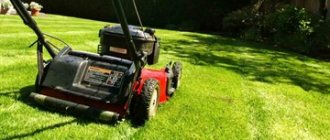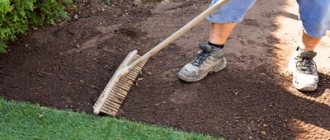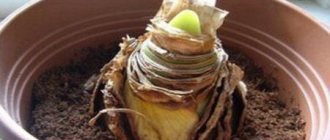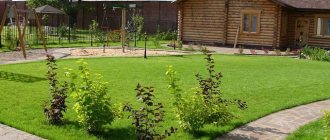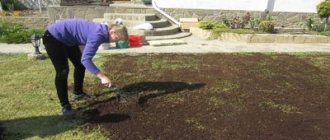There is a lot of hassle with your lawn: does the grass look less decorative than on the package of seeds, does it freeze in places, turns yellow, thins out and is overgrown with weeds? Perhaps you chose the wrong varieties for our climatic conditions. We will tell you today which grass for the lawn is best for you, and which varieties are best to choose.
Rules for choosing seeds for a lawn
The grass on the lawn should be perennial, frost-resistant and fast-growing. These are important conditions for an ideal lawn, but not the most important. We list the main factors for purchasing seeds for sowing on the lawn, which are best chosen in the store:
- Adaptation to certain climate conditions;
- Good development of the root system;
- Saturation of greenery and uniformity of seedlings;
- Ability for vegetative propagation;
- Good haircut tolerance.
You should not neglect the general rules for choosing lawn grass: shelf life of the material, pre-treatment of seeds, manufacturer’s warranties, etc.
A short video about lawn grass
Types of grasses and lawn mixtures
It is best to use grasses for the lawn. They have a good root system, produce uniform green shoots, help remove weeds and have an excellent decorative appearance after cutting. The most commonly sown varieties of grass are meadow bluegrass, bentgrass, ryegrass, fescue and others. Various grass mixtures are also popular.
Ryegrass is one of the elite varieties of grass. It looks very beautiful in any place free from planting. This variety is sensitive to watering and loves mineral fertilizing.
Herbal mixtures
- Universal mixture. The herbs in this mixture have rapid germination, tolerance to external conditions, remove weeds and are inexpensive. The only negative is that such a lawn requires frequent mowing.
- Sports varieties. This is a type of cereal mixture for playgrounds, stadiums and places for active recreation.
- Mixtures for specific climates. It is important to choose grass varieties for the lawn not only by appearance, but also by climatic characteristics. There are special mixtures for areas that are under the scorching sun. If you want to sow shady areas, you should pay attention to shade-tolerant varieties of grass.
- Mixtures of flowers and herbs. Such compositions are sown to create a meadow-type lawn. You can choose ready-made mixtures of forbs or create a mix of flowers and grasses that can bloom in turns throughout the summer. For a neat, bright meadow lawn, low-growing greenery is suitable, and you can decorate the area in a rustic style with the help of tall herbs and flowers.
- Elite composition for lawn. Although the mixture of elite herbs is capricious and sensitive to external conditions, its appearance justifies all means. Such herbs look very decorative and can decorate any unplanted areas.
The best varieties of lawn grasses for the Russian climate
1. Meadow bluegrass. This perennial variety is one of the earliest cereals. In its pure form, it is practically not sown, since the roots of this grass take root slowly. Bluegrass is an excellent base for a grass mixture. It produces soft and juicy greens, crowds out weeds and grows well with other grains.
Bluegrass is the best base for a lawn grass mixture. The variety is unpretentious, produces vigorous shoots and can grow on poor soils
Meadow grass is a fast-growing grass, the shoots of which you will see earlier than other crops. It looks bright and very decorative
2. Polevitsa. The dark, rich green of fine bentgrass looks good in any lawn. This grass can withstand frequent mowing, cold winters, and will remove weeds over time.
Thin bentgrass grows densely, without bald spots. It withstands frequent haircuts, practically does not freeze and has a rich green color.
3. Ryegrass. This grass can be found in grass mixtures for lawns. It has excellent decorative qualities, but does not tolerate Russian winters well. Therefore, in its pure form it can be sown only in the southern regions of our country, or used as an annual lawn.
Ryegrass has leaves of medium width. This variety grows very quickly, so some gardeners prefer not to cut it. You can often find ryegrass as part of elite grass mixtures
4. Fescue. Fescue is an ideal lawn grass that does not require special care, both in mono form and as part of a forb. Within a month, the fescue sprouts thickly and is ready for shearing.
Fescue is an excellent grass for the lawn, both in its pure form and as part of a forb. Its succulent shoots appear quickly and fill the lawn with thick greenery
The most common questions about lawn grasses
Our experts will answer the most frequently asked questions of novice gardeners:
1. Why is ordinary grass not suitable for a lawn?
Lawn grass does not deplete the soil, as ordinary weeds do, has small roots and looks much more decorative. The sown grass will grow evenly and improve its decorative appearance after each new cutting.
2. How long does lawn grass take to grow?
Lawn grasses are perennial. The seedlings will take on a decorative appearance within 1-2 months after sowing. If you properly care for your green lawn, mow it on time, feed it and water it regularly, your lawn will delight you for many years.
Green ryegrass shoots will decorate any lawn. This grass is very thermophilic, so a lawn made of pure ryegrass can only be annual
3. What is the difference between a grass mixture and a single variety of seed?
You can choose a monoculture (one variety of grass) or a mixture of several species. Sowing of one variety is carried out for elite plots, playgrounds and decorative lawns. Such grass, although it produces a lush decorative carpet of greenery, is more expensive and sensitive to care and external conditions. Herb mixtures are more sustainable, produce uniform greens and require less maintenance.
4. How to get uniform shoots?
It is necessary to prepare the soil well, level it, removing debris and weeds. A hand seeder will help you sow cereal seeds evenly on your lawn. If you don’t have one, mix the seeds in half with sand and sow them in the ground. After the first year of life, the grass may develop bald patches that need to be sown with new seeds in the spring.
Fescue does not require special care and tolerates sun, partial shade and harsh Russian winters.
Ready-made grass in a roll is a very convenient option for a quick lawn. You just need to lay the rolls correctly, and the lawn is ready. The only disadvantage of such a lawn is the high price
A seeded lawn is a great way to remove weeds and decorate your yard profitably. A green lawn refreshes the yard and pleases the eye. Now all that remains is to decide what kind of lawn grass will grow on your site.
Recently, lawn grass has become increasingly popular among domestic agronomists. Beginners in this business often wonder how long after planting the grass will germinate. The answer will depend on many factors, which will be discussed in today’s article.
How long does it take for lawn grass to sprout after sowing?
How long does it take for lawn grass planted in spring to emerge? How quickly does a lawn emerge after sowing in the summer? Late spring and early summer are the most favorable times to sow grass mixtures for your lawn. Several factors depend on how quickly seedlings emerge. First of all, this is a type of lawn grass.
- Red fescue is the main component of shade-tolerant grass mixtures. Subject to all agrotechnical rules and favorable weather conditions, seedlings should sprout in 7-12 days.
- To grow a parterre lawn, several varieties of fescue, bentgrass and meadow grass are used. When planting in spring and summer, seedlings should germinate after 9-13 days. If you sow in the fall, the seedlings will sprout in the spring.
- Flower and cereal crops are used to decorate the Moorish lawn. Depending on weather conditions (temperature and humidity), the quality of the seed and compliance with the rules of care, the duration of seedlings may be from 9 to 16 days.
- An ordinary lawn is not inferior in its decorative properties to those listed above, however, there are several varieties. Bluegrass will take 10-20 days to germinate, while ryegrass will take at least a week.
How long does it take for lawn grass to sprout after sowing?
Why doesn't it grow well?
Uneven germination of grass in the area may be due to poor quality seeds.
To make sure that the products are not defective, when purchasing you should:
- carefully inspect the packaging. Seeds are supplied in kraft bags and polypropylene bags. The first ones should be tightly sewn on a special machine, the second ones should be sealed. If the package is sealed with tape, it has most likely been opened. This is done when the storage conditions of the goods are violated. For example, a bag was soaked and its contents were poured into another container. Or they checked the seeds for mold;
- pay attention to the presence of the label and its contents. Reliable manufacturers, in addition to the name of the grass mixture, also indicate its composition. Sellers are required to present product certificates to the buyer.
After examining the packaging, we begin to examine the contents. Healthy seeds smell like grass; their mass should not contain impurities in the form of straw, twigs and other types of debris.
You need to have an idea of the appearance of the seeds of the plants that you plan to use to decorate your lawn. Otherwise, it is difficult to ensure that the seeds correspond to the declared varieties. If the buyer has never seen live samples, high-quality photographs can help him in this matter.
If the seed material has passed visual inspection, proceed to testing for germination:
- Place a small amount of grains on cotton wool or a rag moistened with water;
- Place the “incubator” in a dark place for two weeks. During this time, it is necessary to maintain the humidity of the substrate. You cannot fill it with water;
- after 14 days, begin counting sprouted and dead seeds.
Germination time of lawn grass depending on its type
The main factor that influences the timing of germination is the type of plants chosen. At the same time, we can highlight several of the most popular options, which are especially loved by the owners of suburban areas. These include the following solutions:
- Cereals. The germination time of lawn grass is quite short - from 8 to 12 days. However, such plants quickly lose color saturation.
- "Wild" lawn. It is created from clover, chamomile and yarrow. Moreover, the varieties have different ripening times. So, clover will sprout already on the 10th day after planting, and yarrow - only on the 20th.
- Parterre. This option includes bentgrass, which will decorate the lawn in 12 days.
Homemade potato planter for a walk-behind tractor with your own hands - dimensions and drawing
It is also worth highlighting city lawns, which are included within 10 days. Moreover, there are special rolls for decorating areas - plants have already been grown on them. However, they lose their appearance faster and will cost the owner significantly more.
Soil preparation.
First you need to clear the area for the future lawn.
To do this, you need to remove all debris, remove as many weeds and tree shoots as possible, and level the ground. Proper leveling of the soil will allow the lawn to rise quickly and evenly, so you should fulfill all the requirements: - make a slight slope from the center of your site to its edges, this will allow excess water to drain and eliminate stagnation and freezing.
“To destroy weeds, you need to resort to specialized chemicals. preparations, the main thing here is not to overdo it, so that components harmful to plants do not accumulate in the soil.” Of course, the best option would be to completely avoid chemicals, but sometimes it becomes impossible to remove all the weeds manually. Special fertilizers and peat will improve soil fertility. It is not recommended to use fresh manure because it may contain a lot of weed seeds. Before planting, the soil must be loosened. The depth of loosening should be about twenty centimeters. The drainage system is considered one of the most important factors affecting the germination of a lawn. When preparing a site for planting lawn grass seeds, it must be carefully prepared.
Red fescue
This plant is the most popular for country lawns.
Red fescue is a loose-bush, perennial grass; its development type is winter; it forms creeping rhizomes. In nature, it is often found in meadow areas, when it is not cut, it can reach a height of 20 to 70 cm.
The plant creates a dense turf, and a large number of shoots and narrow, beautiful leaves help create a uniform lawn covering.
Red fescue blooms in late May - early June, but this can hardly be observed on a well-kept lawn, since regular mowing prevents flowering from appearing.
The herb has a number of benefits:
- tolerates frost and low mowing;
- has the ability to recover from mechanical damage;
- with its help you can create an attractive, even lawn, and it is inexpensive.
Although red fescue is a fast-growing plant, some fluctuations in its growth are observed. After it is sown (in the first year), the grass grows weakly, but will delight you with a beautiful green carpet in the next couple of years.
To create decorative coverings, it is best to sow fescue from May to September, then the lawn will be well strengthened by winter. The first shoots can be observed after 10-14 days. Don't be alarmed if you have empty spaces in the area at first. Fescue has uneven germination; the full picture of the lawn coverage can be seen in 4-6 weeks.
Sowing seeds in August
Planting a lawn in August is convenient for those whose area is not ready for planting a lawn in the spring. It will take a long time to prepare the site, but if it is ready by early summer, you should postpone sowing until autumn, when conditions are more suitable for grass growth.
Sowing seeds
The time for sowing should be chosen so that at least 40 days remain before the onset of frost. This period will be enough for the seeds to sprout, and the plants will reach the required height, and the roots will have time to get stronger. In the middle zone and Moscow region, the lawn is planted in September. It is advisable to complete sowing work before September 10, the deadline is September 25. If planting is carried out later, the plants will not have time to grow stronger and will die.
So you can plant seeds in August, the plants will have enough time to get stronger for winter.
Perennial ryegrass
To answer the question of how long it takes for lawn grass to sprout, it is necessary to consider the characteristics of the most popular plants. These include ryegrass, which is famous for its rather hard turf layer. This feature prevents the development of various weeds, which is convenient for the owner.
The average growth period for ryegrass is 7-12 days. Moreover, it has a fairly fast development cycle, as it begins to bush within 21 days. For this reason, the plant is planted quite early - it will be the first to please the eye of the lawn owner. As a rule, sowing occurs at the end of March. Thus, by mid-April the first formed layer appears.
Ryegrass is quite tolerant of light frosts and shade. However, in severe frosts it may well die. For this reason, it is worth keeping a close eye on the weather before landing. If the temperature is still low, you should postpone the procedure until April. In this case, the lawn will be formed by May.
Types of Lawn Grass
Depending on life expectancy there are:
- annual crops;
- biennial crops;
- perennial crops.
The life cycle of annual crops takes place in just 1 year. This type of plant includes phacelia, common comb, and wheatgrass.
In the first year of their life, biennial crops form and strengthen the root system, grow stems and leaves. In the second year, shoots will appear, from which flowers and fruits will develop. After the seeds ripen, the plants die. Among the biennial lawn plants we can name alfalfa.
Perennial crops, unlike biennial and annual plants, continue their growth and development for several years after the seeds ripen. Among the variety of perennial grasses, one can highlight meadow fescue, bentgrass, and white clover.
Depending on the root system, the following types of plants can be distinguished:
- dense bush;
- rhizomatous;
- taproot;
- loose bush.
In densely bushy plants, old shoots released by the aboveground bush quickly grow together with new ones and form dense nodes. Such plants resemble a dense bush. There are old parts inside it, and fresh, new parts around the edges. Separate varieties of fescue belong to dense bush crops.
In rhizomatous plants, the root is not deep, but it grows rapidly and produces a large number of nodes that form above-ground shoots. Among the rhizomatous grasses, meadow foxtail and white bentgrass can be distinguished.
The root of taproot plants goes quite deep into the ground and fresh shoots appear on it. Such plants form beautiful lush bushes. Taproot crops include some types of alfalfa, sainfoin and several varieties of clover.
The root of loose bush plants forms one node, and the splendor is created by the shoots of the above-ground part. Loose-bush plants include such plants as meadow fescue, wheatgrass, rhizomatous wheatgrass and others.
Is the time when leaves appear different when planting at home?
Growing crops at home is practically no different from growing them outdoors. Sorrel also needs regular watering, loosening the soil, removing weeds and feeding with fertilizers.
- You only need to water with warm water; cold water from the tap will not work.
- In summer, when it gets hot outside, you need to carefully monitor the condition of the soil and water more often. In winter, on the contrary, water a little less often.
- About once a week before watering, the soil needs to be loosened and, if necessary, all weeds must be removed.
- You can feed the soil in pots with mineral fertilizers such as superphosphate, potassium chloride and urea.
- Sorrel tolerates darkening well, so the northern and northwestern sides of the apartment are suitable for growing it.
- For normal growth and development, the temperature in the apartment should be from 5 to 20 degrees.
Buy green manure seeds l Russian Seeds online store
Hybrid clover (pink) is one of the most valuable legumes. Used for green fodder, hay and grazing. Its feed mass has a somewhat bitter taste, and therefore it is fed to livestock along with other herbs. Clover is an excellent honey plant; bees readily pollinate it; honey productivity is 100-130 kg/ha. Under favorable conditions, seeds germinate 9-12 days after sowing. Due to its high yield, it produces a good harvest of green fodder. Clover is often grown in combination with various grass mixtures as lawn grass; it is resistant to trampling. The plant produces many shoots, thereby increasing food production. On pastures, clover improves the palatability of grass eaten by livestock. When grown together with cereal crops, clover is suppressed and thinned out.
bentgrass
These flexible cereals are very common in Russia. With their help, you can create a lawn covering very simply and affordably. Most often, bent grass is used to create meadow, sports, garden and park lawns, areas for children's active games, and it is also used to strengthen slopes. In Great Britain, the highest class lawns are created from a mixture of red fescue and bentgrass.
Bentgrass is classified as a perennial short-rhizome grassland grass. It creates a felt-like turf and develops an excellent root system consisting of many small roots, due to this the arable layers of the soil are very firmly held together.
How and how to wash and remove stains from stationery barcode corrector from clothes
The plant has the following advantages:
- unpretentious to soil composition;
- she is not afraid of pests, diseases and trampling;
- winters well;
- good with low haircuts and light shading;
- during dry periods, the leaves on the shoots dry out, but as soon as moderate weather conditions are restored, the bentgrass resumes its growing season and the covering again takes on a beautiful appearance.
The bentgrass sprouts 9-14 days after planting the seeds, and after another month it begins to bush.
Diseases and pests
So, all the norms have been met, the site has been watered, but the lawn has not sprouted well? Perhaps there are pathogenic bacteria or garden pests in your area that are destroying the grass. The main manifestation of this disease is yellow spots on the lawn. They can have smooth, clear edges or be blurry, completely cover the area or be localized only in one part of it. The most well-known problems causing this lawn condition are: Mycelium (witch rings); Fungal spores; Grass diseases caused by poor care (rust, etc.); Flies or fly larvae; Rodents (moles, hamsters, mice, shrews). In this case, the fight against bald spots can be achieved only after the cause of their appearance has been established. It is recommended to set traps for rodents; control of insects is possible only with insecticides intended for ornamental grasses. You should also review the correct care of the coating and carry out some restorative procedures.
Factors affecting grass germination
How quickly a lawn emerges after sowing depends on a number of indicators. For this reason, gardeners try to predict the most suitable time for planting. To do this, you should carefully monitor the weather. If there is still frost in the early spring morning, the procedure should be postponed. In addition, the following factors are important:
- Presence of shadow. For some varieties this feature will be a positive factor, while for others it will be a negative factor. For this reason, it is important to carefully familiarize yourself with the properties of the selected herbs. So, clover and fescue grow well in the shade.
- Watering level. It should be moderate but regular. So, it is recommended to carry out this procedure every day after disembarkation for a week. This approach will make the plants stronger.
- Timing for preparing the mixture. You should pay attention to this date when choosing packaging in the store. Sets that have been assembled for a long time have a lower germination rate. For this reason, it is worth buying mixtures that were formulated shortly before they hit the store shelf.
In addition, it is worth regularly piercing the soil - once a season. This procedure will saturate the soil with air, which will also help the development of plants.
Wrong haircut
When figuring out why the lawn is drying out, analyze its mowing if you have recently done it. It is required throughout the growing season and often ends with the drying out of the green cover. What mistakes are made?
Haircut length
The lawn may turn yellow and dry out due to the wrong cutting length. If you cut off too much green mass, the root system will begin to wither. In this case, you can try fertilizing with any complex fertilizer (from the companies Fertika, Biona, Orgavit) and abundant (but in moderation) watering.
If you trim only the ends, this will lead to excessive thickness and a struggle for survival. In this case, the lawn often dries out in patches. To revive it, it is necessary to urgently remove the length that is recommended for the variety grown on the site, and no longer allow the intensity and density of plantings.
Weather
If your lawn turns yellow after mowing, it is important what the weather was like when you mowed it. If it rained and the grass was wet, the cuts would be uneven. The same thing happens in hot weather.
The blades of a mower (garden shears) or trimmer line tear the plant tissue, causing serious damage to it. After them, the green cover begins to dry out and in some places may disappear completely.
The same thing happens in hot weather. The blades of a mower (garden shears) or trimmer line tear the plant tissue, causing serious damage to it. After them, the green cover begins to dry out and in some places may disappear completely.
What to do: remove brown spots (uproot faded tufts) and reseed bald spots. If the scale of the tragedy is not so great, you can try to get by with feeding. Any complex fertilizer containing potassium, calcium, phosphorus, copper, nitrogen and iron will be suitable.
In the future, to avoid this, for cutting hair in rainy weather you need:
- periodically switch the mower to idle mode (to relieve the load);
- choose the thinnest line of a certain shape for the trimmer - square or star-shaped.
In hot weather, the green coating is not trimmed, otherwise it quickly turns yellow and dries out.
Further care
These are not all the reasons for the lawn drying out after mowing. With subsequent improper care, the consequences will be yellowness and wilting. What errors lead to this:
- If you do not remove the cut green mass after cutting, a felt plug will form, which prevents the plants from developing.
- If you don’t properly water the soil in the evening after mowing (in the absence of precipitation, of course).
- If you do not add fertilizer as support after such a stressful procedure.
- If you run and walk on a freshly mowed area on the same day.
In addition to the above reasons, poorly sharpened tools and untimely mowing (too frequent or vice versa) also lead to the lawn drying out in places immediately after mowing.
Herbal mixtures
It is worth noting that answering the question of what day lawn grass sprouts can be quite difficult. After all, most gardeners use mixtures of herbs. It includes several varieties, each of which has its own ripening time and advantages. However, they have similar requirements for growing conditions.
As a rule, it necessarily includes bluegrass, fescue, ryegrass and bentgrass. These plants serve as the foundation and make up the majority of the lawn. After all, such varieties are characterized by a beautiful appearance and resistance to negative influences.
In general, the basis of these varieties is formed within 8-16 days. By the end of the third week, they have already created a dense mat of grass. A slight difference in developmental stages allows the lawn to be kept in good condition at all times. If necessary, the gardener just needs to add seeds of one or another variety to the clearing.
It is also worth noting that the main plants are often complemented by other varieties that are contained in the mixture in smaller quantities. The most popular options are clover, yarrow, daisies and grasses. Such plants have a longer development period. However, they allow you to give your lawn a more original appearance.
Drainage system.
The most popular, simple and at the same time the cheapest method of preventing excess moisture on the lawn is the so-called open drainage. To get it, you need to make small trenches along the edges of the site. In the future, excess moisture will be collected in these depressions, and from them will fall into the drainage basin. And yet, in addition to its obvious advantages, this principle of the drainage system also has its disadvantages. Such trenches take up quite a lot of space and significantly spoil the overall appearance of the lawn, and in addition, they require constant maintenance; they must be cleared from time to time and weeds must be removed from them.
“There is also closed drainage, which differs from open drainage in that sand and small crushed stone are poured into the trench.”
With such drainage, the thickness of the layers is usually from fifteen to thirty centimeters, regardless of the quality of the base.
The most modern and effective drainage method is the use of polymer pipes. Such a drainage system consists of special profiles of about one hundred millimeters in cross-section, which are buried to a depth determined by soil conditions.
Now our plot is ready, we have lawn grass in stock, which we managed to buy in advance, having carefully selected it. It's time to sow.
Mushrooms on the lawn - how to fight?
An unpleasant problem awaits owners of areas close to forests. At first glance, the appearance of mushrooms (especially edible ones) on the site is a great success. But most often it is not chanterelles and champignons that appear among the tender grass, but toadstools and fly agaric mushrooms, which not only cause a lot of trouble, but also pose a danger to children and pets. The main problem with mushroom growth is that the grass grows unevenly at the location of the mycelium. Even after removing the caps and legs, the mycelium continues to grow, constantly expanding its “domain”. The sprouting of mushrooms in spots or witch rings is a serious reason to think about moving the green lawn to another, more suitable place. This problem does not disappear for many years and is like an epidemic that is spreading to a larger and larger area. The fight against fungi on the lawn includes several stages: Reducing the amount of fertilizer applied. The high content of nitrogen compounds in the soil provokes the growth of fungi and creates favorable conditions for the development of mycelium. Increased care. Aeration and scarification are especially useful in detecting mycelium. Reduce watering. In moist soil, mushroom growth accelerates significantly. Since the mycelium itself and its spores can remain underground for a long time and not manifest itself in any way, it is worth stopping all activities that have a beneficial effect on its growth. Sprinkling the soil with sand. Sandy soil has excellent drainage and does not provide sufficient nutrient medium for mushrooms to grow. You can learn more about how to remove bald spots on the lawn after mushrooms and witches’ circles in one of our articles.
Is it possible to speed it up?
In the modern agricultural industry, experts have developed many stimulants for the growth of lawn grass. In addition, some folk methods also affect the speed of plant development :
- Ensuring regular watering to moisten the soil. A screwdriver (or other metal rod) should easily penetrate the soil to a depth of 100 - 150 mm.
- Selecting the desired temperature regime - the air should warm up to +10 - 15°C, the soil - to + 8 - 10°C.
- Application of organic fertilizers, which are present in abundance in artificial soil supplied in bags.
- Loosening the soil before planting to ensure soil aeration, which leads to better development of the root system.
- Application of nutritious synthetic fertilizers in dissolved form.
- Construction of topsoil made of fermented peat with the addition of cow or bird manure.
- Fertilize the soil with a mixture of urea and ash, as well as peat immediately before planting.
- By covering the lawn with permeable membranes immediately after sowing, such measures can prevent bird attacks and the destruction of seeds.
- Proper preparation of a freshly planted lawn for winter - if you exclude the germination of seeds at the end of autumn, the first shoots appear on the lawn within a week after the first thaw in the spring.
- Timely fight against the development of mycelium, mold, as well as treatment of grass against diseases caused by their spores.
Before using any synthetic fertilizer, it is recommended to read the instructions on the package, and also ensure abundant irrigation of the planting site to effectively dissolve the particles.
The most popular plants
Meadow bluegrass belongs to the perennial crops of the grass family. The first year after sowing, bluegrass grows quite slowly. At this time, the root system is mainly strengthened. The bluegrass fully develops only in the 2-3rd year. It begins to grow in the spring. At the end of autumn, growth stops and the meadow bluegrass goes green under the snow. Bluegrass will withstand both harsh winters and dry summers. The degree of shade tolerance of bluegrass is average, but it tolerates soil compaction well. After mowing, it grows back quickly, creating an even coverage. Bluegrass is unpretentious to the soil, but the most favorable for its growth is humus-rich, moist and non-acidic soil.
Red fescue belongs to the perennial grasses. This plant has excellent drought resistance and shade tolerance. In addition, fescue tolerates cold well, so it easily survives winters. This grass is resistant to trampling, tolerates regular mowing well, and the best height for mowing is 4-5 cm. Red fescue grows more intensively and more easily on loose soils saturated with humus.
Common bentgrass belongs to the perennial grasses. It is winter-hardy and shade-tolerant. The bentgrass grows slowly during the first year after sowing, and receives its full development in the 2-3rd year after sowing. Growth occurs until late autumn, and the bentgrass disappears into the snow in its green form. The bentgrass is very resistant to abrasion and tolerates mowing well. It does not grow back very quickly, but evenly. It is unpretentious to the type of soil.
White clover belongs to perennial plants from the legume family. During the first year, development is slow, flowering occurs in the next year. During the season, clover blooms 2 times: the first time - from May to August; the second time - from August to October. Clover does not tolerate shade or excessive moisture. Clover prefers slightly acidic or neutral soil. White clover, in addition to its excellent decorative functions, is capable of bringing benefits - it increases the fertility of the soil, saturating it with nitrogen.
Video on the topic
How long does lawn grass grow after sowing? Answer in the video:
The germination time of lawn grass is influenced by many factors. Some of them cannot be eliminated by humans. But still, most of them are related to compliance with the rules for growing a green lawn.
A properly selected grass mixture and a carefully prepared site will ensure the success of the enterprise. And if you fail, you shouldn’t be too upset: only experienced agricultural technicians can get a good grass carpet the first time.
Advice from experienced agronomists
How long does the lawn grow, what prevents the seeds from germinating? These and many other questions concern newcomers to this field. Experts recommend paying attention to the following points:
- Often the reason for the lack of seedlings is the use of low-quality seed material. Before purchasing seeds, you need to pay attention to the expiration dates and quality of the seed.
- In order for plants to actively develop, mineral and organic fertilizers must be added to the soil.
Lawn grass can create an attractive picture in every summer cottage, but in order to get the desired result, you need to familiarize yourself with agrotechnical rules and cultivation features.
Seedlings do not germinate well: reasons
If the grass mixture was successfully chosen, then soon the agronomist will be able to contemplate an attractive green living carpet on his plot. But in some areas, seedlings may germinate poorly or unevenly. There may be several reasons:
- Failure to comply with all sowing rules. The optimal immersion depth of the seed is no more than 2-5 mm. In this case, the seeds are protected from drying out and attacks by pests; they are able to provide themselves with the optimal amount of nutrients from the soil.
- Another equally common problem is an uneven lawn. Most often, seedlings do not appear in lowlands and on hills. To achieve the desired result, it is recommended to first level the area allocated for the lawn before sowing.
How many days does it take for cabbage to sprout after sowing?
Note! Sometimes, seedlings may not appear well due to soil damage by diseases or pests.
If seedlings do not appear at all, then you should familiarize yourself with the following most common reasons:
- Lack of drainage layer, poor drainage.
- Low soil moisture.
- Wrong time for sowing.
- Excess or deficiency of the norm for sowing.
- Nutrient deficiency in the soil.
Seedlings germinate poorly
Meadow bluegrass
How long it takes for lawn grass to sprout depends on the selected variety. After all, there are more than 100 varieties of bluegrass in nature. The approximate germination time is 12-16 days. In this case, the plant appears gradually. For this reason, the formation of a thick mat should only be expected after 3-4 weeks.
It is worth noting that bluegrass does not require complex care and retains its color saturation for quite a long time. At the same time, it tolerates both excess moisture in the soil and its lack equally well. In this regard, the plant stands out against the background of other varieties for lawns.
It is also worth noting that bluegrass is a perennial plant. It reaches its peak of development at 2-3 years of age. At the same time, it also creates a dense layer of turf that prevents the development of weeds. This is the reason bluegrass is so popular among gardeners! After all, it is practical to use and has high decorative properties.
